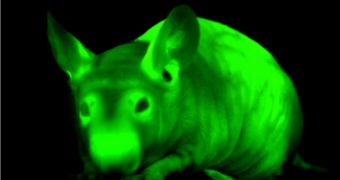Organic light has fascinated mankind for centuries, and the quest to replicate nature's engineering abilities has preoccupied many scientists.
Did you know that some squids use bioluminescence to communicate, or that large groups of jellyfish display an impressive light show when they gather to mate, and even a mushroom attracts insects using bioluminescence to help it spread its spores?
Now, a Cornell University interdisciplinary team of researchers has produced light-emitting fibers, dubbed "nanolamps" about the size of a virus or the tiniest of bacteria.
Until now, the most used organic light-emitting diode (OLED), in which the emissive layer comprises a thin-film of certain organic compounds, were 8 mm thick.
"Nanolamps" are made up of synthetic fibers (a compound based on the metallic element ruthenium) just 200 nanometers wide (1 nanometer is one-billionth of a meter), so small that they are less than the wavelength of the light they emit.
The foundation for the light effect is provided by a technique called electrospinning, a technique through which researchers spun the fibers from a mixture of the metal complex ruthenium tris-bipyridine and the polymer polyethylene oxide.
As a result, the fibers give off orange light when excited by low voltage through micro-patterned electrodes, not unlike a tiny light bulb. "Imagine you have a light bulb that is extremely small," said George Malliaras, associate professor of materials science and engineering and director of the Cornell NanoScale Facility. "Then you can use the bulb to illuminate objects that you wouldn't be able to see otherwise."
They used an artistic metaphor to describe the process "like pouring syrup on a pancake on a rotating table. As the syrup is poured, it forms a spiraling pattern on the flat pancake, which in electrospinning is the substrate with micropatterned gold electrodes. The syrup would be the solution containing the metal complex-polymer mixture in solvent. A high voltage between a microfabricated tip and the substrate ejects the solution from the tip, and forms a jet that is stretched and thinned. As the solvent evaporates, the fiber hardens, laying down a solid fiber on the substrate."
The fabrication is simpler and cheaper than traditional methods of high-resolution lithography, in which devices are etched onto pieces of silicon.
There could be many applications for this new technology: Christmas trees that do not need lights, reducing dangerous electronics, glowing trees to line highways to save government electricity bills, agricultural crops and domestic plants that luminesce when they need watering, new methods for detecting bacterial contamination of meats and other foods, bio-identifiers for escaped convicts and mental patients, and possibly even novelty pets that bioluminesce (rabbits, mice, fish etc.)

 14 DAY TRIAL //
14 DAY TRIAL //